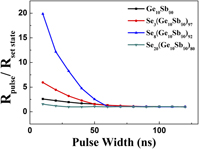Published online by Cambridge University Press: 22 June 2017

In this study, we propose a Se-incorporated Ge10Sb90 as a phase-change material for phase-change memory (PCM) with high reliability and low operation power. We investigated the effect of the Se concentration on the thermal and electrical properties of Se-doped Ge10Sb90 films by varying the Se concentration from 0 to 20 at.%. The crystallization temperature, crystallization activation energy, and maximum ten-year data retention temperature increased with the increasing Se, thus demonstrating the improved thermal stability of Se-doped Ge10Sb90 films with higher Se contents. More Se also increased the rate factor, band gap, threshold voltage, and load resistance. In addition, the crystallization speed, programming window, and resistances of both the amorphous and crystalline states increased with the increasing Se concentration. In contrast, the reset current decreased with the increasing Se concentration. These results demonstrate that Se-doped Ge10Sb90 is a highly promising material for PCM applications.
Contributing Editor: Don W. Shaw